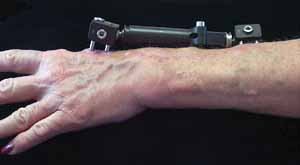Wab, here's what MD Consult says about your wrist fracture. If you would like me to explain the gobbledegook or to check out individual references, just send me a PM.
Meadbh
Disclaimer: I'm not an orthopedic surgeon!
The Wrist: Common Injuries and Management
Katrina Parmelee-Peters, MD
Scott W. Eathorne, MD
DISTAL RADIUS FRACTURE
Distal radius fractures are very common in sports. This injury typically occurs with a FOOSH with hyperextension, impacting the distal radius. The athlete presents with pain, swelling, ecchymosis, and tenderness about the wrist. Initial radiographs should include PA, lateral, and oblique views of the wrist. The examiner needs to determine the type of distal radial fracture and assess displacement, shortening, and intra-articular involvement. The goal of treatment is to correct and maintain radial inclination, palmar tilt, length, and congruity of the distal radial articulations (carpal and ulnar).
A Colles' fracture, the most common distal radius fracture, is a closed fracture of the distal radial metaphysis in which the apex of the distal fragment points in the palmar direction and the hand and wrist are dorsally displaced (Fig. 7). This fracture usually occurs within 2 cm of the articular surface. Colles' fractures are common in adults and rare in children, because children tend to sustain injuries through the distal radial physis.
Stable distal radius fractures may be managed in a short arm cast. All others should be referred for reduction and fixation. A stable distal radius fracture is extra-articular, without comminution, and with minimal or no displacement, which, when reduced to anatomical alignment, does not redisplace back to the original deformity [30]. For optimal outcome, it is important that anatomic alignment of the radius is maintained (either at presentation or with reduction); however, authors differ slightly on the definition of acceptable anatomical alignment. Certainly, fractures must be referred for orthopedic consultation if there is greater than 20° dorsal tilt, loss of radial inclination (20° to 30° need to be maintained), articular step-off greater than 2 mm, or radial shortening greater than 5 mm (Fig. ) [31]. Maintaining radial inclination of 20° to 30°, 4° to 8° palmar tilt, and radial shortening no greater than 2 mm is recommended by Rettig and Trusler [32]. Some texts report that less than 20° of dorsal tilt is stable for closed reduction of a Colles' fracture [30], [33]; however, the reduction needs to be close to anatomic alignment. Laboratory studies demonstrate that alteration of palmar inclination by 20° or more can cause dorsal shift in the scaphoid and lunate, leading to decreased range of motion and high pressure areas on the distal radius [34]. In an individual who normally has 11° of palmar tilt, the maximum acceptable alteration in palmar inclination is 9° of dorsal tilt. Clinical studies also demonstrate that patients who have excessive dorsal tilt are more likely to have poor outcome. McQueen and Jaspers [35] reported on 30 patients who had a Colles' fracture at 4 years follow-up. Patients who had as little as 10° dorsal tilt were much more likely to have pain, stiffness, weakness, and poor function.
Fractures may “settle” or displace in the cast. If healing occurs with a displaced fracture fragment, wrist range of motion will be compromised. A distal radius fracture that is considered stable is managed with a short arm cast, but must be followed with weekly radiographs for at least 3 weeks to ensure that the fracture does not displace in the cast. If cast immobilization is not able to maintain less than 10° of dorsal radial inclination and less than 5 mm radial shortening, internal fixation is recommended [30].
Some surgeons are electing to manage even traditionally stable distal radius fractures with internal fixation. The reason seems to be twofold. The closer to anatomical alignment the fracture is maintained, particularly in palmar tilt, the better the outcome. Also, “stable” fractures may displace with cast immobilization, termed “secondary instability,” and require internal fixation. In a prospective radiological study performed on 170 Colles' fractures that were treated with closed reduction and cast immobilization [36], 29 fractures displaced, requiring further reduction and external fixation. Seventeen additional fractures suffered malunion, with significant increase in radial angulation and decrease in radius length.



